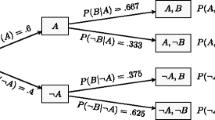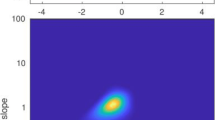Abstract
An adaptive psychometric procedure that places each trial at the current most probable Bayesian estimate of threshold is described. The procedure takes advantage of the common finding that the human psychometric function is invariant in form when expressed as a function of log intensity. The procedure is simple, fast, and efficient, and may be easily implemented on any computer.
Article PDF
Similar content being viewed by others
Avoid common mistakes on your manuscript.
Reference Note
Klein, S. Rapid determination of the psychometric function. Paper presented at the annual meeting of the American Academy of Optometry, Orlando, Florida, December 1981.
References
Cornsweet, T. N. The staircase-method in psychophysics.American Journal of Psychology, 1962,75, 485–491.
Green, D. M., &Luce, R. D. Parallel psychometric functions from a set of independent detectors.Psychological Review, 1975,82, 483–486.
Hall, J. L. Maximum-likelihood sequential procedure for estimation of psychometric functions.Journal of the Acoustical Society of America, 1968,44, 370. (Abstract)
Hall, J. L. Hybrid adaptive procedure for estimation of psychometric functions.Journal of the Acoustical Society of America, 1981,69, 1763–1769.
Hoel.P. G., Port, S. C., &Stone, C. J.Introduction to statistical theory. Boston: Houghton Mifflin, 1971.
Levitt, H. Transformed up-down methods in psychoacoustics.Journal of the Acoustical Society of America, 1971,49, 467–477.
Massof, R. W. Wavelength dependence of the shape of the foveal absolute threshold probability of detection functions.Vision Research, 1981,21, 995–1004.
Nachmias, J. On the psychometric function for contrast detection,Vision Research, 1981,21, 215–223.
Pavel, M. A new adaptive method for forced-choice experiments.Journal of the Optical Society of America, 1981,71, S48. (Abstract)
Pentland, A. Maximum likelihood estimation: The best PEST.Perception & Psychophysics, 1980,28, 377–379.
Quick, R. F. A vector magnitude model of contrast detection.Kybernetik, 1974,16, 65–67.
Roufs, J. A. J. Dynamic properties of vision—VI. Stochastic threshold fluctuations and their effect on flash-to-flicker sensitivity ratio.Vision Research, 1974,14, 871–888.
Taylor, M. M. On the efficiency of psychophysical measurement.Journal of the Acoustical Society of America, 1971,49, 505–508.
Taylor, M. M., &Creelman, C. D. PEST: Efficient estimates on probability functions.Journal of the Acoustical Society of America, 1967,41, 782–787.
Watson, A. B. Probability summation over time.Vision Research, 1979,19, 515–522.
Watson, A. B., &Pelli, D. G. The QUEST staircase procedure.Applied Vision Association Newsletter, 1979,14, 6–7.
Weibull, W. A. A statistical distribution function of wide applicability.Journal of Applied Mechanics, 1951,18, 292–297.
Wetherill, G. B., &Levitt, H. Sequential estimation of points on a psychometric function.British Journal of Mathematical and Statisttcal Psychology, 1965,18, 1–10.
Wilks, S. S.Mathematical statistics. New York: Wiley, 1962.
Author information
Authors and Affiliations
Additional information
The QUEST procedure was developed at the Kenneth Craik Laboratory of Cambridge University. A.B.W. was supported by an NIH postdoctoral fellowship, F32 EY05219. D.G.P. was supported by a British Ministry of Defence grant, “Spatial noise spectra and _target detection/recognition,” to F. W. Campbell.
Rights and permissions
About this article
Cite this article
Watson, A.B., Pelli, D.G. Quest: A Bayesian adaptive psychometric method. Perception & Psychophysics 33, 113–120 (1983). https://doi.org/10.3758/BF03202828
Received:
Accepted:
Issue Date:
DOI: https://doi.org/10.3758/BF03202828




